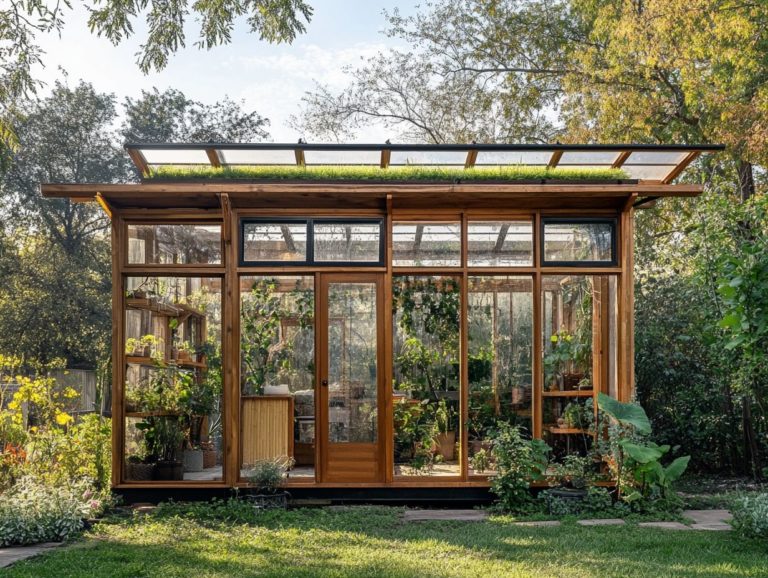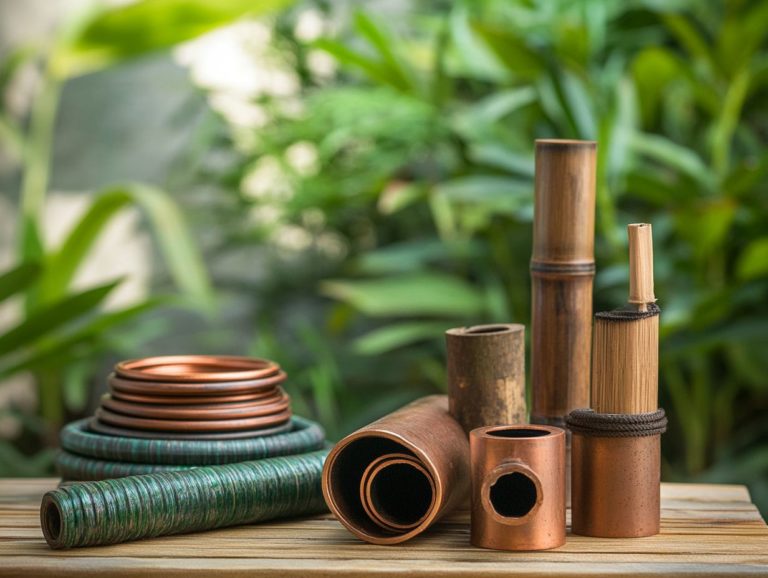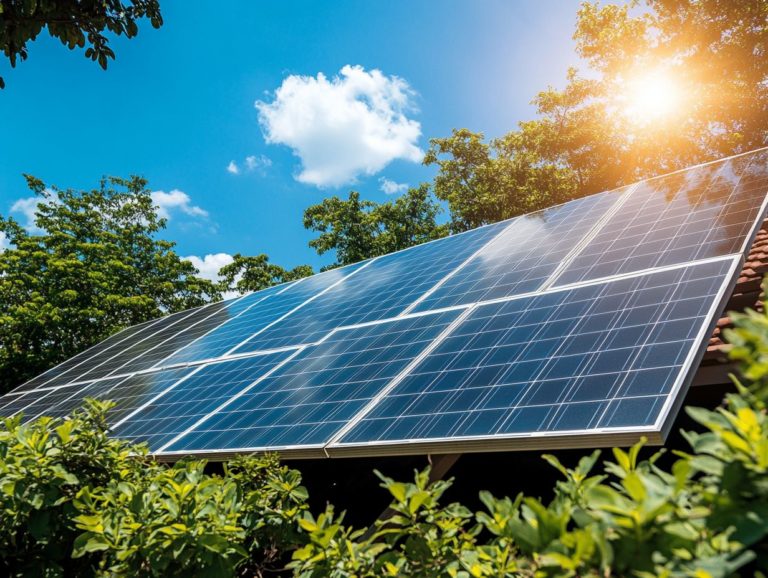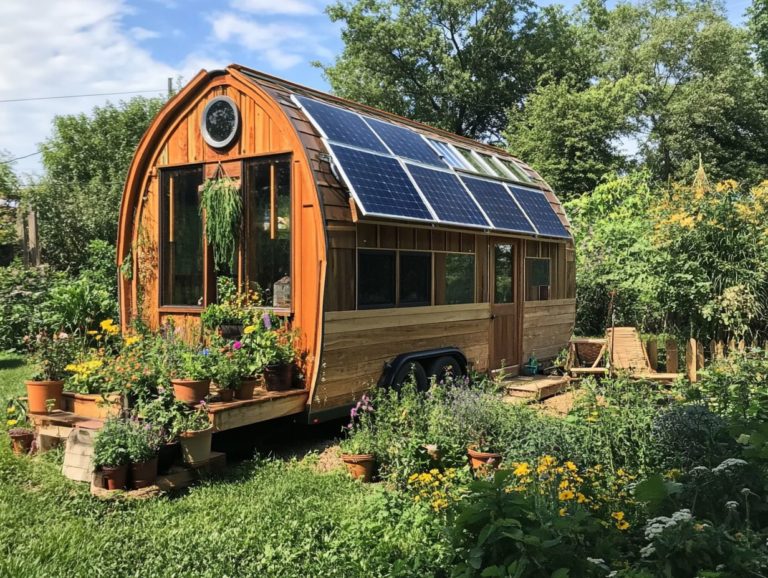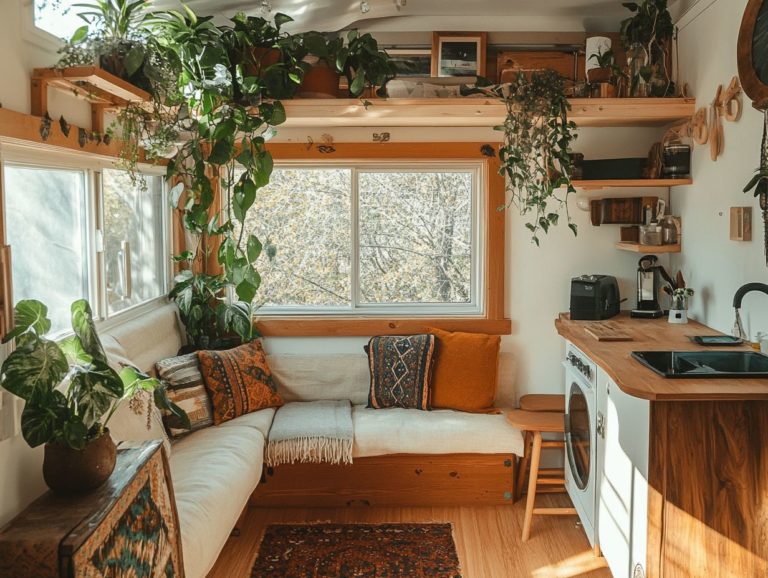Top 10 Sustainable Building Techniques for Tiny Houses
Tiny houses transcend mere trendiness; they embody a lifestyle choice that champions sustainability and minimalism.
As you delve into the top 10 sustainable building techniques for tiny homes, you’ll uncover innovative strategies like passive solar design, rainwater harvesting, and the clever use of recycled materials. These methods not only minimize environmental impact but also foster the creation of efficient, eco-friendly living spaces.
Let s explore how tiny houses can transform your life, providing practical solutions and long-term cost savings that benefit both you and the planet.
Contents [hide]
- Key Takeaways:
- 1. Passive Solar Design
- 2. Use of Recycled Materials
- 3. Rainwater Harvesting
- 4. Composting Toilets
- 5. Energy-Efficient Appliances and Lighting
- 6. Green Roof
- 7. Solar Panels
- 8. Greywater Recycling
- 9. Natural Insulation
- 10. Multi-Functional Furniture
- How Can Tiny Houses Be More Sustainable Than Traditional Homes?
- Key Principles of Sustainable Building
- Challenges of Implementing Sustainable Techniques in Tiny Houses
- How to Incorporate Sustainable Building Techniques into Your Tiny House Design
- What Are the Long-Term Cost Savings of Using Eco-Friendly Methods in Tiny Houses?
- What Are Some Examples of Successful Sustainable Tiny House Projects?
- Frequently Asked Questions
- What are the top 10 eco-friendly building techniques for tiny houses?
- How can recycled materials be used in eco-friendly building for tiny houses?
- What are the benefits of incorporating passive solar design in tiny house construction with solar panels?
- How can energy-efficient appliances be used in sustainable tiny house building?
- What are some examples of sustainable insulation for tiny houses?
- What is the purpose of implementing rainwater harvesting systems in tiny house construction?
- How can green roofs be incorporated into sustainable tiny house building?
- What are the benefits of using solar panels in tiny house construction?
- How can smart home technology be utilized in sustainable tiny house building?
- What are some eco-friendly flooring options for tiny houses?
- How can low-VOC paints be used in sustainable tiny house building?
Key Takeaways:
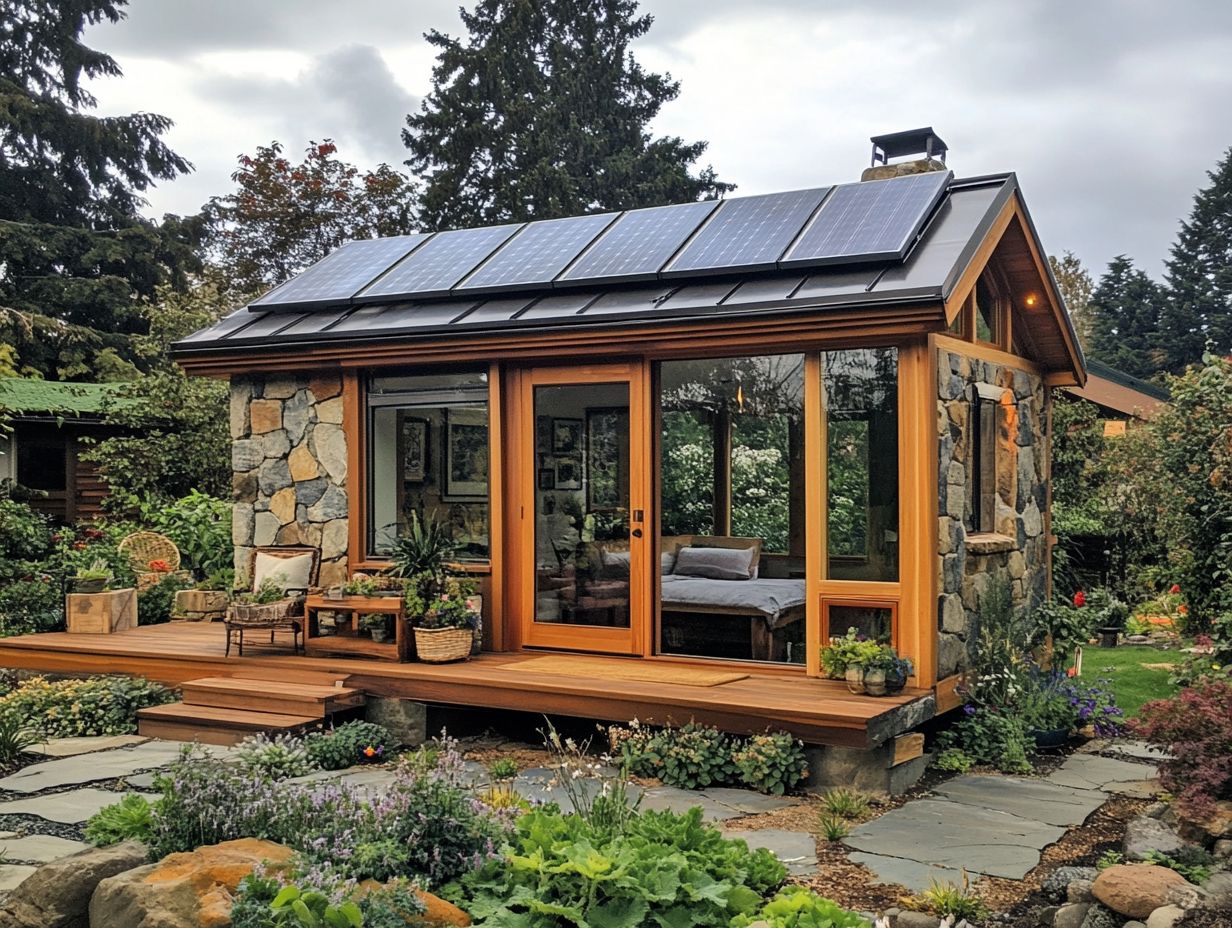
- Incorporating passive solar design in tiny houses can significantly reduce energy consumption and carbon emissions.
- Using recycled materials and implementing rainwater harvesting can minimize waste and conserve natural resources in tiny house construction.
- Utilizing multi-functional furniture and energy-efficient appliances can save space and reduce energy usage and costs in tiny houses.
1. Passive Solar Design
Passive solar design represents a smart building design that optimizes sunlight for both heating and lighting. This method is particularly crucial for sustainable living, especially in tiny homes where maximizing space and energy efficiency is vital to minimizing your carbon footprint.
By thoughtfully considering the building’s orientation, you can effectively harness the sun’s path, allowing bright sunlight to pour in during the winter while keeping heat gain at bay in the summer months. Incorporating thermal mass materials, such as concrete or stone, is equally important; these materials store heat during the day and release it gradually at night, helping to maintain a comfortable indoor temperature.
Strategic window placement is also important, ensuring that natural light reaches deep into your living spaces while promoting ventilation, which cools your home without relying on air conditioning. Together with energy-efficient appliances, these principles can significantly elevate your overall comfort and reduce your dependence on traditional heating methods, guiding you toward a more sustainable lifestyle.
2. Use of Recycled Materials
The use of recycled materials in construction marks a significant stride toward sustainable building practices, allowing you to create eco-friendly tiny homes that are both visually appealing and environmentally responsible.
Materials like reclaimed wood and bamboo have surged in popularity thanks to their sustainable sourcing and minimal environmental impact. Reclaimed wood not only infuses character into your designs but also helps reduce the demand for new lumber, playing a crucial role in preserving our precious forests.
On the other hand, bamboo, with its impressive growth rate, stands out as a renewable resource, perfect for various structural applications. Innovative techniques such as modular construction and 3D printing have emerged as true game-changers, enabling you to use these recycled materials with remarkable efficiency.
These methods promote waste reduction and facilitate the creation of durable, high-quality homes with a smaller ecological footprint, showcasing a balanced approach to modern living. Incorporating sustainable plumbing materials can further enhance this effort.
3. Rainwater Harvesting
Rainwater harvesting stands as a crucial practice for sustainable living, especially in tiny home communities where resource efficiency can dramatically lessen reliance on municipal water systems.
This approach encompasses various collection systems, like rooftops paired with gutters that direct rainwater into storage tanks. You can elevate these systems with filtration techniques, such as sediment filters and UV light purification, ensuring the water quality meets your everyday needs.
By seamlessly integrating rainwater harvesting with greywater systems where water from sinks and showers is reused you can amplify your community’s water conservation efforts. This combined strategy not only trims your water bills but also has a positive environmental impact by reducing runoff and lessening the strain on freshwater sources.
4. Composting Toilets
Composting toilets represent a smart solution for sustainable living, offering you eco-friendly sanitation options that significantly minimize water usage and reduce your environmental footprint. This is particularly advantageous in tiny home communities.
These systems harness natural processes to transform human waste into compost, effectively converting a potential hazard into a valuable resource. Composting toilets can dramatically reduce your water consumption, a feature that is crucial in regions grappling with drought conditions.
These toilets also manage waste effectively while producing nutrient-rich compost that’s perfect for your gardening endeavors. Regular maintenance requires periodic emptying of the composting chamber, but the effort involved is minimal compared to traditional sewage systems.
Ultimately, the contribution of composting toilets to fostering a circular economy is a must-have for eco-conscious living!
5. Energy-Efficient Appliances and Lighting
Energy-efficient appliances and lighting are essential in your journey toward sustainable living. They significantly cut down on energy consumption and reduce your carbon footprint in tiny homes through thoughtful choices and modern technologies, including Energy Star certified products.
By selecting Energy Star-certified refrigerators, dishwashers, and washers, you ensure your daily routines are not only effective but also responsible. Switching to LED lighting not only reduces electricity usage but also extends the lifespan of your fixtures, helping minimize waste.
These choices can significantly impact your monthly utility bills, allowing you to redirect those savings toward even more sustainable practices. Embracing these options aligns seamlessly with the minimalist living philosophy inherent in tiny home designs.
6. Green Roof
Green roofs represent a modern design element that elevates energy efficiency while offering natural insulation and a thriving habitat for indoor plants. They seamlessly blend nature with modern living, particularly in tiny homes.
These innovative designs contribute to substantial energy savings by slashing heating and cooling costs. They also play an essential role in stormwater management by absorbing rainwater, diminishing the risk of flooding and alleviating the strain on urban drainage systems.
This eco-friendly approach supports biodiversity, attracting vital pollinators crucial for maintaining ecological balance. Integrating vegetation into urban landscapes does wonders for air quality by filtering out pollutants and enhancing aesthetic appeal.
This creates tranquil green spaces that promote mental well-being and encourage community engagement.
7. Solar Panels
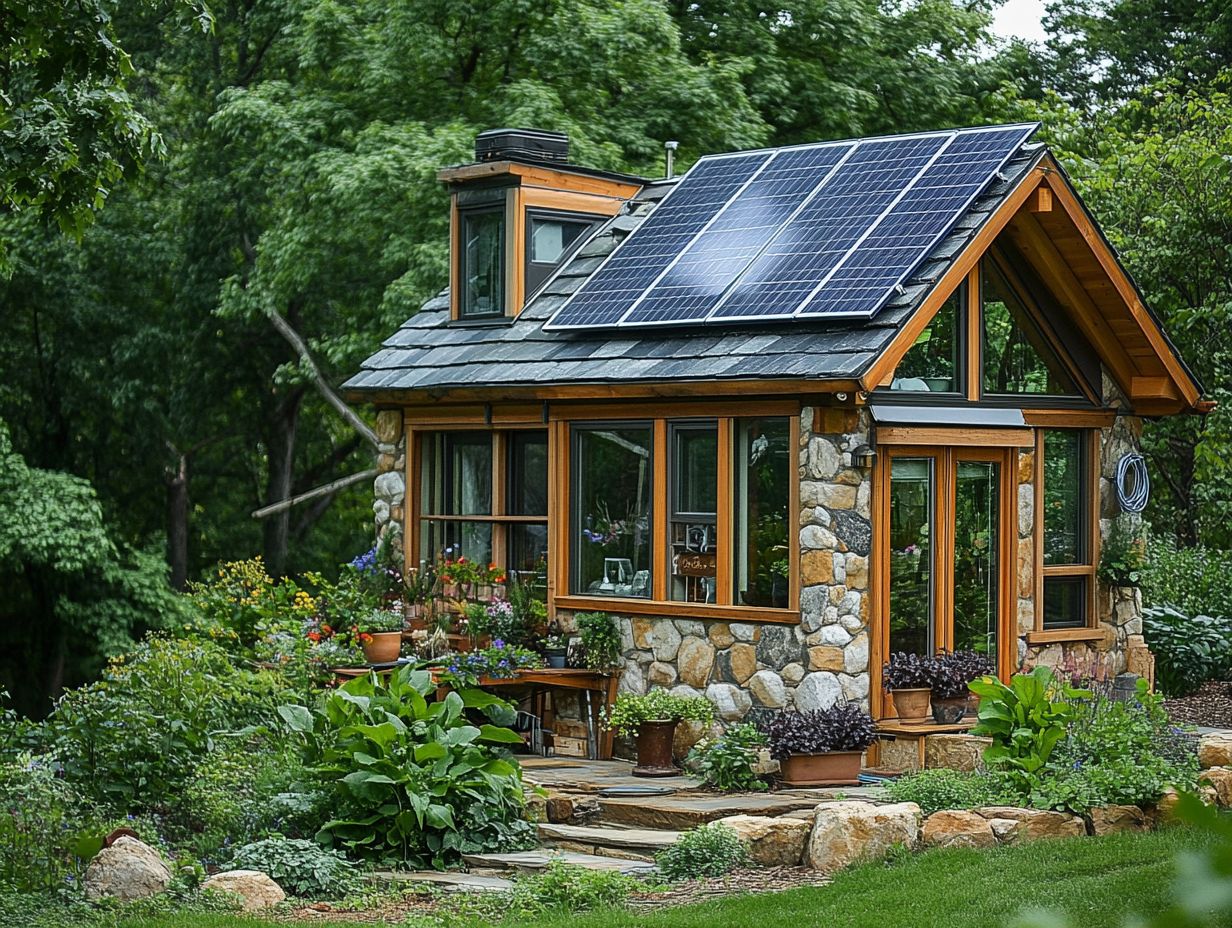
Solar panels stand as a cornerstone of sustainable living, providing renewable energy solutions that enhance the energy efficiency of your tiny home while reducing reliance on fossil fuels. They are an integral part of a Passive House, a type of home designed to be highly energy-efficient.
By incorporating solar technology, you gain the freedom to choose from various systems that align with your lifestyle. Grid-tied solar setups connect seamlessly to the main power grid, allowing you to enjoy the benefits of net metering and energy savings.
On the other hand, off-grid systems grant you complete independence from traditional energy sources, ideal for those who embrace a minimalist way of life. The financial perks are noteworthy; lower electricity bills translate into long-term savings that can effectively offset your initial installation costs.
Beyond personal advantages, adopting these systems means contributing to a healthier environment, helping to reduce greenhouse gas emissions and promote cleaner air for future generations. Don t wait to make the switch to energy-efficient appliances every bit counts!
8. Greywater Recycling
Greywater recycling systems are essential for embracing eco-friendly practices in sustainable living. By repurposing water from your sinks and showers for irrigation and other uses that don’t require drinking water, you can instantly boost the sustainability of your tiny home.
These systems operate on the fundamental principles of cleaning and purifying water, ensuring that the reused water is safe for various applications, such as watering gardens or flushing toilets. Incorporating greywater systems allows you to dramatically reduce your reliance on fresh water, contributing meaningfully to conservation efforts.
Combining greywater systems with rainwater harvesting, which captures and stores rain for similar uses, creates a comprehensive water management strategy. This approach maximizes resource efficiency and minimizes environmental impact. Together, these systems offer a seamless pathway to sustainable living, fostering a deeper connection between you and your water sources.
9. Natural Insulation
Natural insulation materials, such as Hempcrete and Polyiso Insulation, are crucial for enhancing energy efficiency in tiny homes. They create a comfortable living environment while significantly reducing your carbon footprint.
These eco-friendly options deliver outstanding thermal resistance, keeping your space cozy in winter and refreshingly cool in summer. They also offer impressive breathability, a feature that traditional materials often lack. Choosing materials like sheep’s wool, cellulose, or straw bales provides even more benefits, as they are renewable and biodegradable.
By opting for these natural insulation alternatives, you play a vital role in reducing landfill waste and minimizing resource consumption. This highlights the importance of sustainable materials as you pursue a greener lifestyle.
10. Multi-Functional Furniture
Multi-functional furniture is a true game-changer in the world of tiny homes. It allows you to embrace minimalist living by maximizing space and integrating smart storage solutions without sacrificing style and comfort.
Imagine transforming your space with innovative pieces like sofa beds that effortlessly turn your cozy sitting area into a welcoming guest sleeping space, or expandable dining tables that accommodate larger gatherings without permanently claiming precious real estate in your home.
These clever designs cater to various lifestyles, making it simpler for your family to adapt your living environment to suit your needs. Incorporating such versatile options enables you to craft beautifully organized spaces that reflect your personal taste while prioritizing practicality.
How Can Tiny Houses Be More Sustainable Than Traditional Homes?
Tiny houses embody the principles of sustainable living far more effectively than traditional homes. Their smaller footprint naturally reduces your carbon footprint and encourages community engagement, while often incorporating eco-friendly technologies like modular construction and renewable energy sources.
This innovative approach conserves energy and minimizes resource consumption during the building process. It allows for a variety of creative designs that maximize functionality. For example, tiny home communities in Oregon and Texas showcase how this lifestyle fosters a sense of belonging while utilizing shared resources for gardening and energy solutions. Additionally, you can explore the top 10 tiny house interior design hacks to enhance your living space.
By adopting alternative building techniques such as using recycled materials and clever space-saving designs, you demonstrate a commitment to sustainability that resonates deeply with those who are environmentally conscious. Consider using earthbags for sustainable tiny house building as a unique approach to eco-friendly construction.
Key Principles of Sustainable Building
The key principles of sustainable building focus on maximizing energy efficiency and using eco-friendly materials. These principles also aim to minimize waste during construction to reduce environmental impact.
Thoughtful site selection is essential. It helps you utilize natural light and optimize passive heating and cooling systems. Resource conservation is significant too. You can efficiently reuse water with innovative practices like rainwater harvesting and reusing water from sinks and showers.
Incorporating renewable energy sources, such as solar panels and wind turbines, reduces reliance on non-renewable resources. This paves the way for a greener future. A prime example is the Bullitt Center in Seattle, which showcases energy-positive design and emphasizes sustainably sourced materials. It aligns with the principles of the ENERGY STAR program.
This building serves as a model for your future projects, guiding you toward a lower carbon footprint while fostering ecological balance.
Challenges of Implementing Sustainable Techniques in Tiny Houses
While sustainable techniques in tiny houses offer great benefits, challenges like cost, limited space, and local regulations can make the journey tough.
Financial implications, from the initial investment to ongoing maintenance costs, may feel overwhelming. Zoning laws, often outdated, can restrict how you design and place your tiny home, limiting creativity and functionality. A lack of specialized knowledge in sustainable building practices may also hold you back from fully embracing these approaches.
To overcome these hurdles, consider the following strategies:
- Explore financial assistance through grants or loans aimed at supporting green initiatives.
- Join local advocacy groups to address zoning issues as a community.
- Participate in workshops to gain essential skills for sustainable construction.
By employing these strategies, you can pave a smoother path toward sustainable living in your tiny house.
How to Incorporate Sustainable Building Techniques into Your Tiny House Design
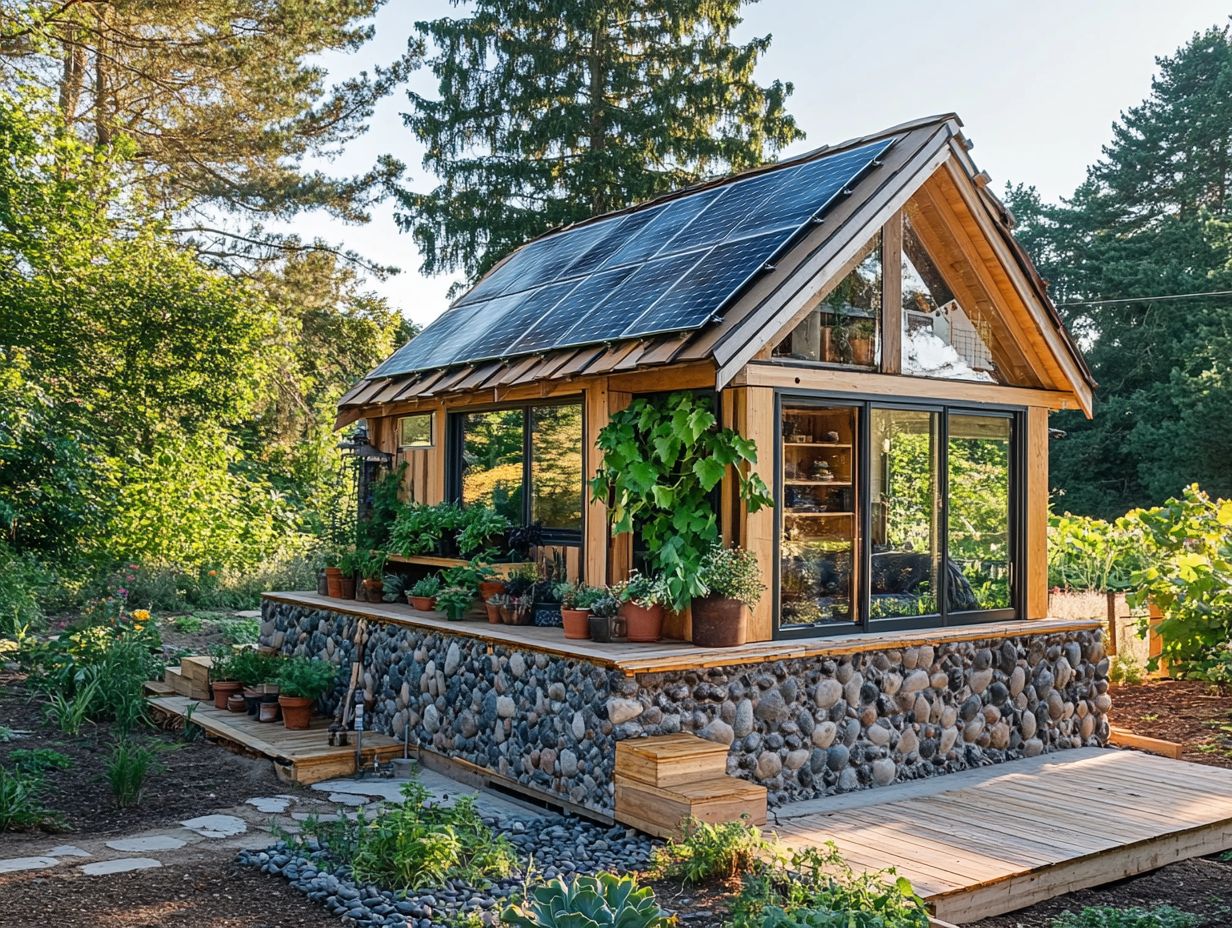
Incorporating sustainable building techniques into your tiny house design is achievable with thoughtful planning. Select eco-friendly materials and energy-efficient systems that enhance both functionality and environmental responsibility.
Prioritizing modular design allows you to maximize living space, creating multifunctional areas. This reduces clutter and encourages an organized lifestyle. Choosing renewable materials, such as bamboo flooring or reclaimed wood, lowers your carbon footprint while adding aesthetic elegance to your home.
Installing energy-efficient appliances, like solar-powered water heaters and LED lighting, significantly cuts down energy consumption. Thoughtful design is crucial in these integrations, ensuring that every decision nurtures the environment without compromising comfort or style.
What Are the Long-Term Cost Savings of Using Eco-Friendly Methods in Tiny Houses?
The long-term cost savings you can achieve by employing eco-friendly methods in tiny houses are significant. Energy-efficient systems and environmentally friendly materials lead to lower utility bills and reduced maintenance costs over time.
For instance, imagine living in a tiny home equipped with energy-efficient appliances. Your monthly electricity expenses could drop considerably. Choosing sustainability is not only good for the Earth it s a smart financial move!
Integrating solar power systems can further reduce your reliance on traditional utilities. This often results in long-term savings that exceed the initial installation costs. Additionally, water-saving technologies, like low-flow fixtures and rainwater harvesting systems, help keep your expenses down and demonstrate the practicality of eco-friendly living.
All these innovations position tiny homes as a forward-thinking investment. When you prioritize eco-conscious choices, you’re not just saving the planet you’re enhancing your economic benefits as a homeowner.
What Are Some Examples of Successful Sustainable Tiny House Projects?
Successful sustainable tiny house projects around the globe highlight innovative design and community engagement. They show how practical and inspiring eco-friendly living can be.
Take the Earthship, for instance. This project emphasizes self-sufficiency by using recycled materials, harnessing solar energy, and collecting rainwater.
Then there’s the Dancing Rabbit Ecovillage, where residents have built a vibrant community dedicated to sustainable practices like permaculture and communal living.
These initiatives do more than just shrink individual ecological footprints; they create a strong sense of belonging and collaboration among residents. They significantly impact the environment by promoting biodiversity, conserving resources, and inspiring others to adopt similar lifestyles.
Frequently Asked Questions
What are the top 10 eco-friendly building techniques for tiny houses?
The top 10 eco-friendly building techniques for tiny houses include: using recycled materials, incorporating passive solar design (which utilizes sunlight for heating and lighting), installing energy-efficient appliances, using sustainable insulation, utilizing rainwater harvesting systems, incorporating green roofs, using solar panels, implementing smart home technology, using sustainable flooring materials, and opting for low-VOC paints.
How can recycled materials be used in eco-friendly building for tiny houses?
Recycled materials can be used in eco-friendly building for tiny houses by repurposing old materials such as wood, metal, and plastic. You can also use salvaged materials from demolished buildings and source reclaimed materials from architectural salvage yards.
What are the benefits of incorporating passive solar design in tiny house construction with solar panels?
Incorporating passive solar design in tiny house construction helps to lower energy costs, increase natural lighting, and improve indoor comfort by using the sun’s heat and light for natural heating and lighting.
How can energy-efficient appliances be used in sustainable tiny house building?
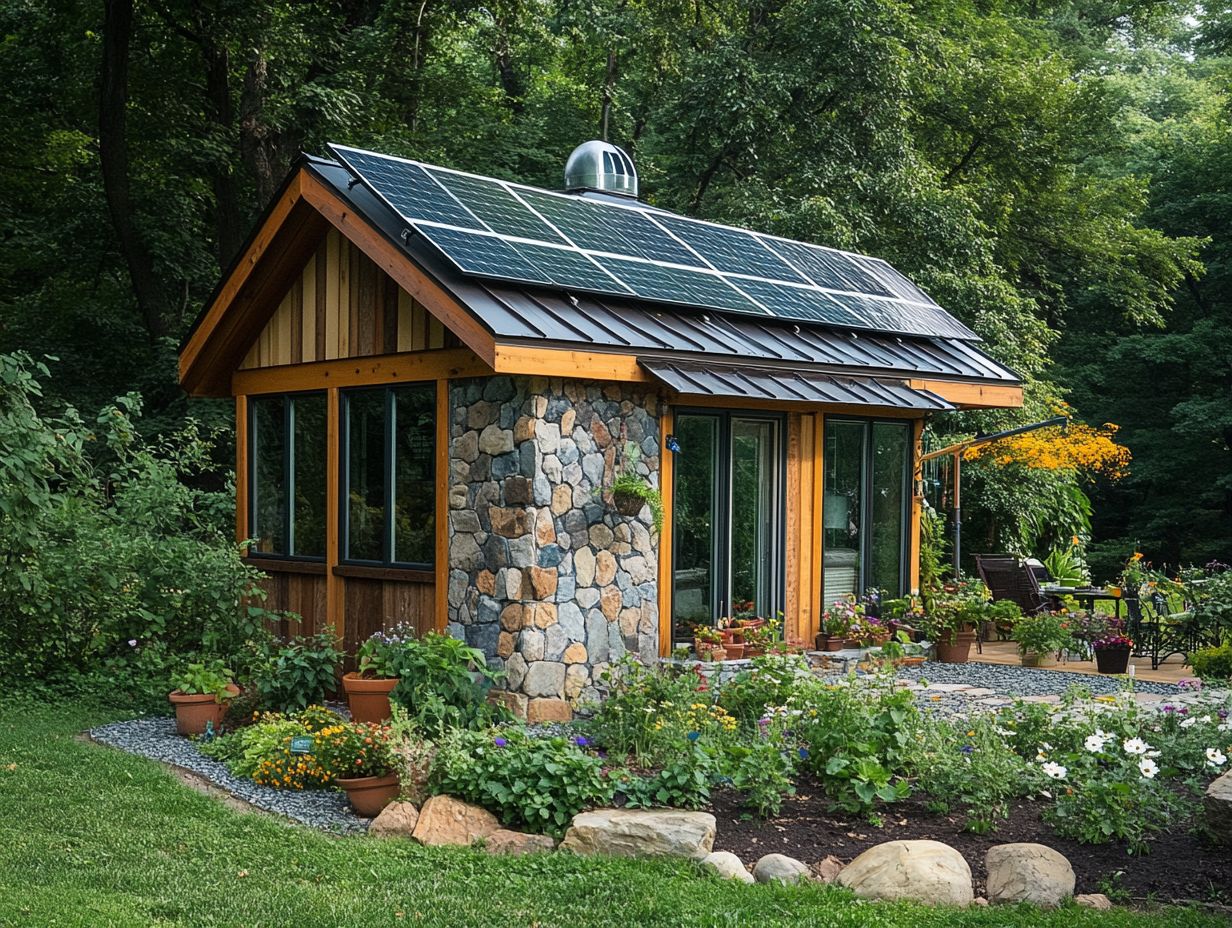
Energy-efficient appliances, such as low-energy refrigerators, washing machines, and dryers, reduce energy consumption and promote a more sustainable lifestyle in tiny house building.
What are some examples of sustainable insulation for tiny houses?
Sustainable insulation options for tiny houses include cork, wool, denim, and hemp insulation. These materials are made from renewable or recycled sources and are free from harmful chemicals.
What is the purpose of implementing rainwater harvesting systems in tiny house construction?
Rainwater harvesting systems collect and store rainwater for various uses, such as watering plants, flushing toilets, and even drinking water. This reduces the need for traditional water sources and promotes sustainability.
Learn more about building your sustainable tiny home today!
How can green roofs be incorporated into sustainable tiny house building?
Green roofs, or living roofs, cover the roof with plants. This provides insulation, reduces stormwater runoff, and improves air quality.
What are the benefits of using solar panels in tiny house construction?
Solar panels cut energy costs and decrease reliance on traditional power sources. They allow tiny house owners to harness the sun’s energy for sustainable living.
How can smart home technology be utilized in sustainable tiny house building?
Smart home technology includes energy-saving devices and programmable thermostats. These tools track energy use and control temperature for better efficiency.
What are some eco-friendly flooring options for tiny houses?
Eco-friendly flooring includes bamboo, cork, reclaimed wood, and linoleum. These materials are sustainable and non-toxic alternatives to standard flooring.
How can low-VOC paints be used in sustainable tiny house building?
Low-VOC paints contain fewer harmful chemicals. They improve indoor air quality and lower environmental impact.

